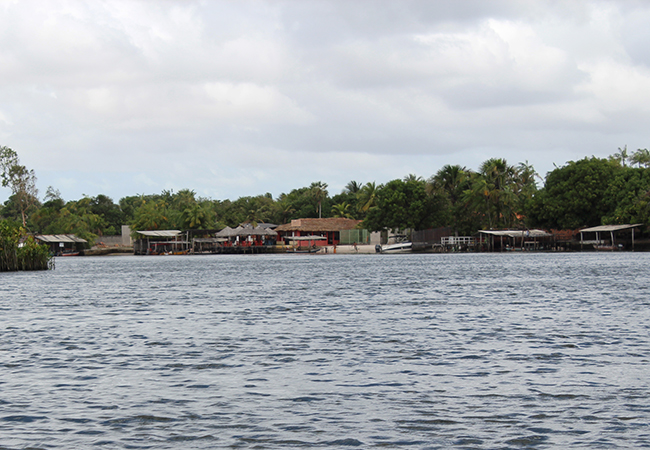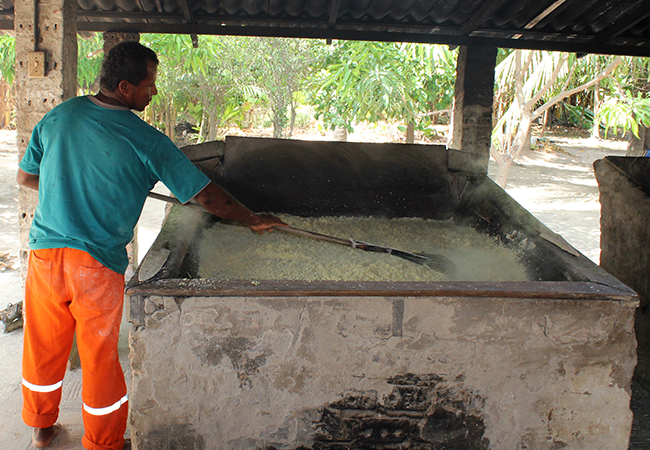Artisan production of flour becomes tourist attraction in Maranhão
February 06, 2018 09h00 AM | Last Updated: February 08, 2018 09h33 AM
Most tourists in the city of Barreirinhas, approximately 260 km away from São Luís (MA), visit Lençóis Maranhenses, famous in Brazil and abroad for its countless dunes and lagoons with crystal-clear waters. It is one of the most sought after sightseeing by those who visit the town. However, there are other tourist attractions in the region that also are worth going to.
One of them is the Tapuio village, located at the margins of Preguiças, the main river in the city. The peculiarity of the place are the so-called furnace houses, also known as flour houses. There visitors can witness the artisan production of flour, from the cassava cutting to the preparation of the product, which is one of the most typical of the Maranhão cuisine. Some tour agencies promote visits to the place, which is a unique opportunity to have a close contact with the rural side of the municipality.
As far as production of flour is concerned, Barreirinhas stands out. According to data from the 2006 Census of Agriculture, conducted by the IBGE, the municipality produced 18,182 metric tons of flour, becoming the second in the city ranking of the biggest producers in Maranhão, just losing to Turiaçu, which was responsible for the production of 40,060 metric tons of flour. In Brazil, the city used to occupy the tenth position among the biggest producers.
Preguiças River
The best way of getting to the place is by boat or motorboat The departure is on the margin of the Beira Rio Avenue, one of the main roads of Barreirinhas, and where there is a little pier, Porto do Janjão, in which the ships are moored. The ride across the Preguiças River, from the departure to Tapuio, takes 30 minutes. Along the ride, tourists can see a unique landscape formed by creeks and native vegetation, with a very rich fauna and flora. They can also enjoy a relaxing ride on the clean and calm waters that flow lazily along 120 km to run into the Atlantic Ocean in the Atins village.
Throughout the way up to Tapuio, the boat traffic is intense, with not only tourists, but also residents that use boats for the transportation from the remotest villages up to downtown. During the ride, we can see that the river splits two distinct realities. On a certain part of the way, on one of the river margins, we can see luxurious restaurants, hotels and homes for season rent. On the other margin, life flows more slowly, with children swimming and adults working on fishing nets or repairing boats.
At this point, villages by the river start to show; further, the remotest and most visited ones appear, such as Vassouras, Caburé and Atins. The region landscape is filled with an immense amount of palm trees of several kinds, big trees with large roots and an intricate vegetation at various spots on the margin of the Preguiças.







Production process
Arriving at the village, where ships are usually moored, there are the furnace houses of the region. At the place, the predominance of rustic equipment in the process of artisan production of flour calls the attention of the tourists.
After harvesting the cassava, the product is peeled and washed to be grated later. Next, the resulting mass goes into a press where it is compressed and from which all the liquid is drawn. After that, the sieving process is carried out for the removal of impurities while the flour becames more homogeneous. Later, the product is goes to a furnace, which is similar to a large plate, and is constantly stirred until it is well roasted. After this phase, the flour is ready for consumption and commercialization.
Cleudo Ramos Sousa, 42 years old, works at the furnace house with the flour production. Having lived in the Laranjeiras village since he was 12 years old, he operates the furnace and does some fishing as well in order to provide for his family. He is a living proof that the artisan production of flour is an activity that passes from generation to generation. "My parents taught me and now I live here," said the resident.
Cassava growing
The production of flour in Barreirinhas supports the great cultivation of cassava in the region. According to IBGE’s Municipal Agricultural Survey (PAM), the city was the top producer of cassava in Maranhão in 2016, with a production of 46,500 metric tons, and the eighth greatest producer in the Northeast.
Maranhão is well ranked when it comes to cassava farming. Data from PAM also show that the state was the second biggest producer of cassava in the Northeast, with a production of 1,305,850 metric tons, losing only to Bahia, which produced 1,956,103 metric tons. In the whole country, Maranhão ranks fourth among the largest producers, losing to Pará (4,263,013 metric tons), Paraná (3,888,111 metric tons) and Bahia (1,956,103 metric tons).
Indispensable in the dietary intake of many people in Maranhão, cassava flour is rich in carbohydrates. As part of the regional cuisine, the product in its pure form is consumed with juçara (palm heart), with coffee or with fish stew, for example. In addition, the farofa, whether it made of dry flour or water flour (made from mashed yeasted cavassa), can be consumed as a side dish in a several kinds of meals. The cuisine of Maranhão is proof of the multiple ways in which flour can be used.




















